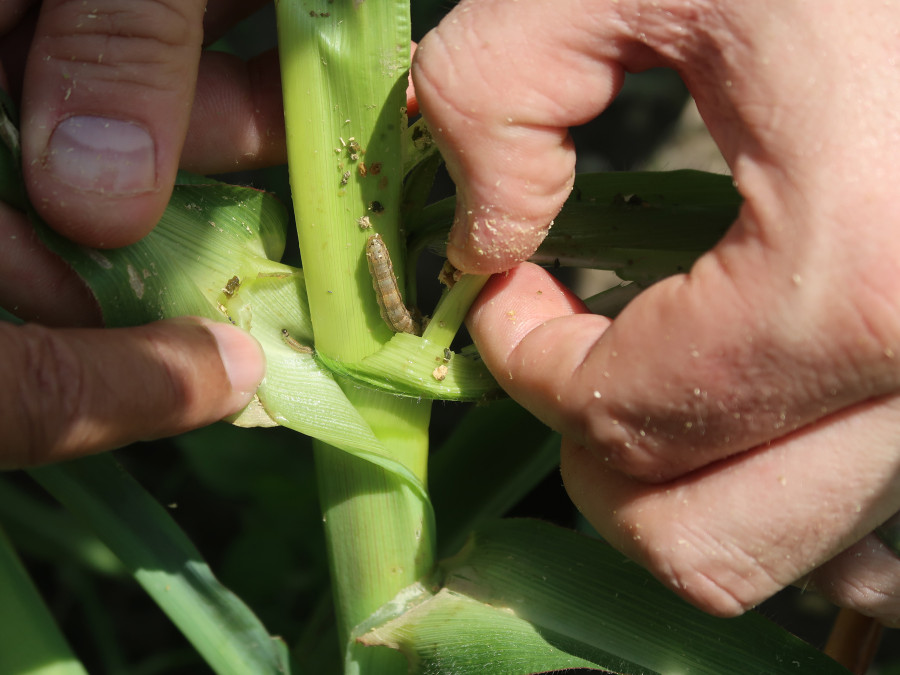Columns
An army of worms
As the temperature warms up, the invasive fall armyworm could make a comeback.
Bandana Pradhan
The destructive fall armyworm that arrived in Nepal in 2019 will strike again. The next time it will cause long-term effects on crop yields for thousands of farmers if effective and immediate measures are not taken.
After multiple surveillance field visits and the investigation of many suspected samples, the Government of Nepal’s Plant Quarantine and Pesticide Management Centre (PQPMC) declared the invasion of fall armyworm on 12 August 2019. The insect is an international quarantine pest and a major threat to maize production and productivity.
The fall armyworm did not do much damage to Nepal last year due to the cold weather, but the pest is likely to reappear and attack thousands of hectares of maize fields this coming spring season, if not managed properly. As increasing temperatures will escalate the reproduction of this hungry pest, a rapid response is required to combat this emerging threat.
A migratory insect-pest native to the Americas, the fall armyworm has caused a significant loss estimated in billions of dollars in many African countries that grow maize since it was first identified on the African continent in 2016. In Africa, the fall armyworm has the potential to cause maize yield losses ranging from 21 to 53 percent destroying 8.3 to 20.6 million tons of the annual production if left uncontrolled (Abraham et al., 2017; Day et al., 2017). It presents a serious threat to food and income security to millions of smallholder farmers. Growing in tropical weather conditions, the female moth of a fall armyworm can lay thousands of eggs in her lifetime and the moth’s strong flying capability makes it difficult to eradicate.
The pest is reported to have infested maize fields in all maize growing districts of Nepal, although the level of damage varies from place to place.
A collective effort and broad mobilisation is needed to sustainably control the fall armyworm and limit the spread of this invasive pest. The Ministry of Agriculture and Livestock Development (MOALD) has been established a special task force to fight back the pest. Most of the provinces have established similar task forces constituting researchers, agriculture extension agents, farmers and various entrepreneur associations. Nationwide, the initiative to manage the fall armyworm is being coordinated by the National Plant Protection Organization (NPPO) of Nepal under the MOALD. The members of the task force are creating awareness among farmers, strengthening the capacity of communities, service providers, institutions and government, and disseminating appropriate technologies and management techniques that will detect, mitigate, and manage this pest.
‘The government, private institutions, research centres, donors, universities and civil society organisations are monitoring the outbreak and developing a coordinated response to combat this pest’, said Sahadev Prasad Humagain, Chief of PQPMC.
Farmers in Nepal must learn how to identify and manage this pest. To support the transfer of knowledge in the farm communities, the national task force has developed factsheets about fall armyworm for local dissemination.
USAID’s Feed the Future Nepal Seed and Fertilizer Project has supported the PQPMC since the threat first emerged in Nepal. In collaboration with PQPMC, there was an educational video for farmers which had guidance on how to identify and scout fall armyworms in maize fields.
Under the Nepal Seed and Fertilizer Project, CIMMYT is also seeking linkages with international experts to develop scientific solutions to tackle the fall armyworm. A recently developed mobile application used for scouting and monitoring fall armyworm in Bangladesh is being explored with the possibility of rolling it out in Nepal.
Similarly, the task force is working with provincial governments and various stakeholders to raise awareness and preparedness by organising workshops and community mobilisation initiatives. But at the same time, private sector engagement is important in disseminating integrated pest management (IPM) practices and technologies to farmers. What’s more, seamless collaboration is necessary among major stakeholders in the country to collectively fight the pest. Without this coordination, the effect of the damage could be much worse than expected.
***
What do you think?
Dear reader, we’d like to hear from you. We regularly publish letters to the editor on contemporary issues or direct responses to something the Post has recently published. Please send your letters to [email protected] with "Letter to the Editor" in the subject line. Please include your name, location, and a contact address so one of our editors can reach out to you.




 16.24°C Kathmandu
16.24°C Kathmandu















